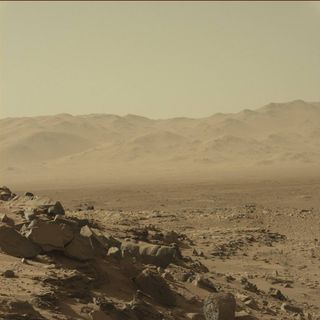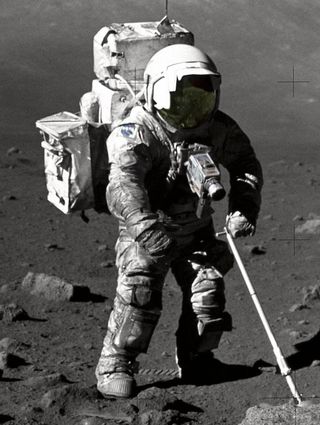
What Does Mars Smell Like?

Robot explorers have found Mars to be a world of sulfur, acids, magnesium, iron and chlorine compounds, all of which are sunbaked and wrapped in a carbon-dioxide-rich atmosphere.
But what would this complex and exotic brew smell like?
It turns out that everyone — not just Mars explorers — might be able to find out, because there may be ways to recreate whiffs of the Red Planet here on Earth. [The 7 Biggest Mysteries of Mars]
Headspace tech
One relatively recent innovation in the perfume business is "Headspace" technology.
"It gathers the molecules, and then the sample is brought back to the lab to be analyzed by spectral analysis. The results are typically synthesized to create a scent that mimics the smell of those molecules," said Jacquelyn Ford Morie, founder and chief scientist of the California-based company All These Worlds LLC, which uses virtual reality (VR) and other technology to create "immersive experiences" for a variety of applications.

Morie thinks Headspace, or something like it, could be used to decode the smell of Mars.
"I think that new artisan fragrance designers would love to design a series of scents that are their own, nonsampled interpretations of what Mars might smell like," she told Space.com.
Get the Space.com Newsletter
Breaking space news, the latest updates on rocket launches, skywatching events and more!
A future mission could take a spectroscopic reading of the Martian atmosphere, then beam that information back to Earth, where Headspace hardware could reconstruct (or evoke) the Red Planet scent, Morie added.
"That's the cool thing about the artisan scent designers," she said. "They can add the more stinky elements to make a scent that hints at the real Mars while still being cool to smell. Many top fragrances have small bits of those otherwise smelly elements in them."
Eau de Red Planet

Morie suspects that the predominant Mars odor is a slightly acrid, gassy smell of sulfur compounds, with a chalky, sweet overtone punching through. This scent would become a big part of Red Planet settlers' lives.
"Imagine 30 or 40 years from now, when we have established colonies on Mars, and the colonists have become not only accepting of the scented detritus they track into their habitats, but actually consider it the smell of home," Morie said.
Future colonists could perhaps also use finely crafted habitat scents as harmonious counterpoints to the native smells of their adopted planet, she added.
Studies have shown repeatedly that smell is intimately tied to memory; whiffs of a familiar scent can trigger nostalgia and other strong feelings about times long past.
So, if Mars colonists "need to return to Earth, they would absolutely require a vial or two of 'Eau de Red Planet' to remind them of their life on this distant human outpost," Morie said.
Extraterrestrial encounters
Decoding or replicating Mars' scent would not be the first extraterrestrial encounter of the odor kind.
During the Apollo lunar landing program, for example, some of the moonwalkers noticed that they had brought back rock and dust particles into their lunar module. The material tainted their spacesuits. Once the astronauts took off their helmets, the moon's smell — which was likened to wet ashes in a fireplace, or spent gunpowder from a just-fired shotgun — was evident.
Then, in 1998, scientists with New York-based International Flavors & Fragrances Inc. (IFF) sent a miniature rose plant aboard the space shuttle Discovery on its STS-95 mission, to study the effect of microgravity on scent.

Using proprietary technologies, the team, led by Braja Mookherjee, tracked radical shifts in the living flower's scent over the course of the shuttle flight.
"Ultimately, they discovered and created new-to-world profiles that have since gone on to enormous commercial success," IFF representatives wrote in a blog post late last year.
In addition, artisan Carrie Paterson has investigated making scents of life on Earth that can be embedded as olfactory information into multichannel interstellar messages. Then, there's the work of designer Saskia Wilson-Brown, who's interested in finding out what UFOs might smell like.
Leonard David is author of "Mars: Our Future on the Red Planet," to be published by National Geographic this October. The book is a companion to the National Geographic Channel six-part series coming in November. A longtime writer for Space.com, David has been reporting on the space industry for more than five decades. Follow us @Spacedotcom, Facebook or Google+. Originally published on Space.com.
Join our Space Forums to keep talking space on the latest missions, night sky and more! And if you have a news tip, correction or comment, let us know at: community@space.com.

Leonard David is an award-winning space journalist who has been reporting on space activities for more than 50 years. Currently writing as Space.com's Space Insider Columnist among his other projects, Leonard has authored numerous books on space exploration, Mars missions and more, with his latest being "Moon Rush: The New Space Race" published in 2019 by National Geographic. He also wrote "Mars: Our Future on the Red Planet" released in 2016 by National Geographic. Leonard has served as a correspondent for SpaceNews, Scientific American and Aerospace America for the AIAA. He was received many awards, including the first Ordway Award for Sustained Excellence in Spaceflight History in 2015 at the AAS Wernher von Braun Memorial Symposium. You can find out Leonard's latest project at his website and on Twitter.
